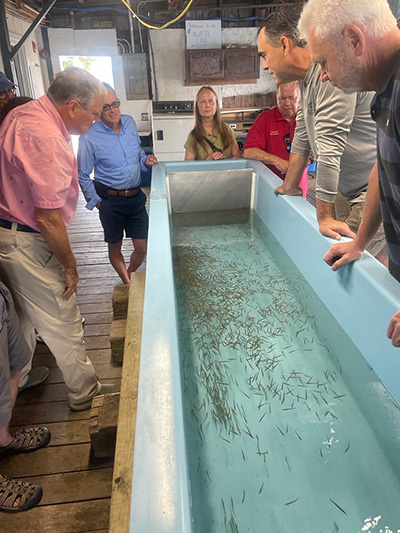RIVER DISCOVERY
Newsletter for the Friends of the Thousand Islands Biological Station
From the Bluff
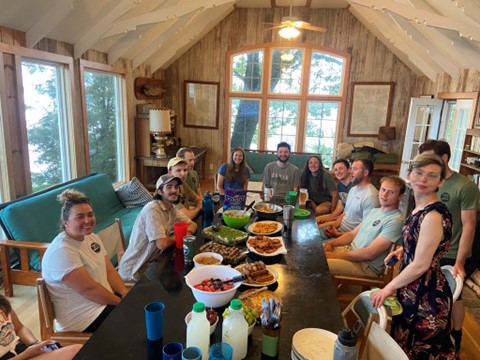
Photo: TIBS students and staff enjoy a potluck dinner in the main lodge on Governors Island. Pictured from left to right: Katelyn Barhite, Garrit Coddington, Josh Mackecknie, Thornton Ritz, Alyvia Nazak, Jack Marshall, Georgie Hoffman, Jackson Booth, Robby Weber, Michael Umstead, Andrew Parnas, and Jamie Schutz.
Dear TIBS (Thousand Islands Biological Station) Friends! The 2022 crew at Governors Island is having a monumental year. I am so proud of the dedicated work and contributions being made. The achievements are due to our community of amazing people. They include a crop of seven new undergraduates (Alyvia, Garrit, Georgia, Jack, Jamie, Josh, Mike) and two new graduate students (Jackson and Andrew) in addition to returning graduates (Amanda, Anna, Katelyn, Thornton), our professional staff (JP, Robby) and an abundance of volunteers from the US Fish and Wildlife Service, the DEC, and the Thousand Islands Land Trust, and our TIBS Friends. I hope you enjoy this River Discovery newsletter issue that highlights some of the recent activities. As examples, we raised and released over 53,000 young muskies for the recovery program! We also launched the new Muskellunge Citizen Science program. TIBS has two new student scholarships and we reached over 100 TIBS Friends members and worked with many groups and partners this year. TIBS continued to lead critical data collection to gauge the health of the river, and students are working on research projects involving invasive species and pathogens, river water quality, wetlands, fish gut microbiome, walleye critical habitat, muskellunge population restoration and others!
We winterized the Governors Island facility but our labs and work at ESF (Environmental Science and Forestry) campus continues to bustle as we process and analyze the samples and information collected.
We continue to make progress towards our research and conservation management goals and education and training mission areas.
Thank you for your continued generous support as a TIBS Friend!
Using Citizen Science to Track Recovery of the St. Lawrence River Muskie Population
The Muskellunge Citizen Science program has recently developed a community of concerned anglers to participate in the assessment of a population recovery effort led by TIBS. The program will improve our ability to track the progress of the ongoing restoration.
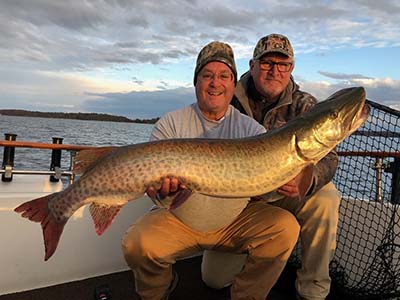
Photo: Andy Skop, TIBS Friend and St. Lawrence River muskellunge angler, has success out of Clayton, NY.
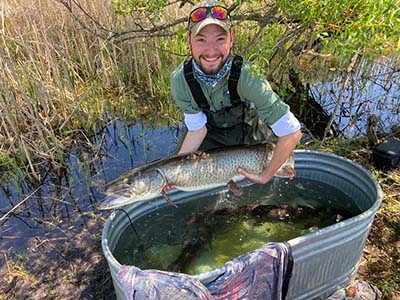 Photo: TIBS technician and ESF student, Jack Marshall holds an adult muskellunge captured
in the spring trapnet survey that was used in egg take for the Muskellunge Recovery
Program.
Photo: TIBS technician and ESF student, Jack Marshall holds an adult muskellunge captured
in the spring trapnet survey that was used in egg take for the Muskellunge Recovery
Program.
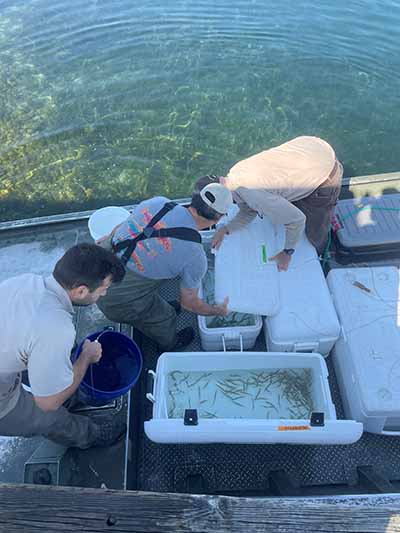 Photo: Fingerlings are cultured at the TIBS conservation hatchery and given a PIT
tag and released in hopes that they will survive to spawn on their own. TIBS researchers
load boat with muskellunge to release at restoration sites.
Photo: Fingerlings are cultured at the TIBS conservation hatchery and given a PIT
tag and released in hopes that they will survive to spawn on their own. TIBS researchers
load boat with muskellunge to release at restoration sites.

Photo: The Antique Boat Museum graciously hosts our first Muskie Citizen Science Workshop to train anglers on data collection.
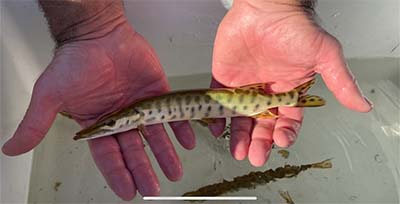 Photo: Fall seining crews recaptured muskies tagged and released in nursery areas
earlier this summer. The tags were read and information on individual fish growth
and survival was obtained to help evaluate program success.
Photo: Fall seining crews recaptured muskies tagged and released in nursery areas
earlier this summer. The tags were read and information on individual fish growth
and survival was obtained to help evaluate program success.
The muskie recovery effort is needed to address population losses related to an invasive pathogen (VHS) and establishment of exotic round goby which carries the disease (see article by Anna Conklyn, this issue). In collaboration with New York DEC and the USFWS Cortland Field Office, a muskellunge culture and stocking research plan was implemented in 2017 in an experimental effort to restore muskellunge populations lost to the disease. Stocking is needed to serve as a pulse of reproduction to rebuild lost spawning muskellunge, with an end goal of re-building this naturally sustaining population and fishery. In 2022, 35,000 fry and 18,000 fingerling muskellunge were raised in the lab at TIBS on Governors Island and released in the river and eastern Lake Ontario. Fingerlings received an internal passive integrated transponder (PIT) tag, which is smaller than a grain of rice that the fish will carry throughout its life (upwards of 25-30 years). Each tag has a unique numeric code used to identify individual fish, that can be read with a handheld tag reader. The handheld reader and tagging provides a tool used by scientists and our Muskellunge Citizen Science program participants for assessment of recovery program success by estimating survival of young to adulthood (muskie mature in about 6-8 years) and other critical information such as growth rates, movements, and where fish go to spawn.
With the Muskellunge Citizen Science program, anglers received PIT tag detectors and tag insertion and detection training, critical to Muskellunge Recovery Program assessment. Each angler participant has the tools to read tags, insert new tags, and collect other data about the fish they catch, including tissue samples for genetic analysis. Genetics data provides additional critical information to assess muskellunge population health. We held the training in July at the Antique Boat Museum with program participants and then visited the TIBS lab. ESF TV producer, Christopher Baycura created an educational video used to help educate the angling community about the program.
Engaging the public through the Muskellunge Citizen Science Program for this important research represents a vital collaboration in muskellunge conservation that involves not only scientists and managers but also the anglers themselves and partners including Save The River and the Thousand Islands Land Trust. Key donations from Muskies Canada, Muskies Inc., DK Musky Lures, and The Northern New York Community Foundation have also helped get this program off the ground. We look forward to updating and involving TIBS Friends with this latest adaptation of a successful effort to sustain and rebuild our muskellunge population.
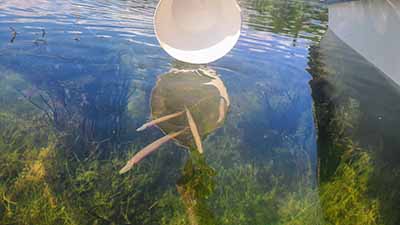 Photo: Fingerling muskie being released at Chippewa Bay, one of 65 sites in the region,
to receive fish for population recovery program. In all, over 53,000 lab reared muskies
were released in 2022, an enormous effort made possible by the hard-working students,
staff, and partners!
Photo: Fingerling muskie being released at Chippewa Bay, one of 65 sites in the region,
to receive fish for population recovery program. In all, over 53,000 lab reared muskies
were released in 2022, an enormous effort made possible by the hard-working students,
staff, and partners!
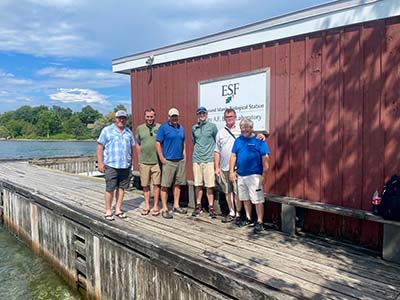
Photo: Musky citizen science anglers visit TIBS and stop for a photo in front of the boathouse.
First Ever TIBS Endowed Student Summer Scholarship Created Thanks to Gift from Nels and Debbie Magnuson
We are indebted to Nels and Debbie for their first-of-its-kind scholarship to benefit students studying at the station. The gift will “support a deserving ESF undergraduate or graduate student to participate in our aquatic research program on the St. Lawrence River,” said Dr. John Farrell, TIBS director. “The students will learn how to conduct science and monitoring in the field and in our labs that will benefit them through professional training as well as contribute to conservation and management of fisheries, habitats, and biological diversity of the river.”
Each year a deserving student (either undergraduate or graduate level) will be selected to live and conduct research on the St. Lawrence River as part of the TIBS crew. This is a potentially life-changing and formative experience to develop as an environmental scientist. Many students get their first real research opportunity here and this individual will interact with established scientists and other students engaged in science to protect the river and its ecosystems, biodiversity, and fishery.
The Magnusons, who are actively involved in conservation efforts in the region through the Thousand Islands Land Trust, learned about TIBS when Farrell was involved in the restoration of the Blind Bay marsh in Hammond, where they have a summer home.
“We have long supported a sustainable St. Lawrence River habitat and decided to support the important work being done at TIBS by endowing a student internship,” Nels Magnuson wrote in an email. “We hope the internship provides experiences furthering students’ interest in careers supporting a sustainable environment.”
The Magnusons visited the station in the summer of 2021 accompanied by their 6-year-old grandson, who has a budding interest in science. Having lived in central and northern New York for many years, the couple has “seen the positive impact of ESF,” Nels Magnuson said.
John gave us a tour, introduced us to several students who discussed their work, and put together an exhibit with a number of river critters for our grandson,” said Nels. They were also able to watch a group of students collect samples from the river.
“The Magnusons joined our new Friends of TIBS program in 2021 to support and engage more with the research station,” said Brandy Neveldine, an ESF major gift officer. “This extraordinary gift will impact so many students in perpetuity and help ensure the work done at TIBS continues to benefit the region into the future.”
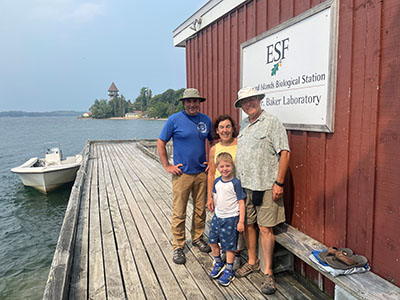 Photo: Nels, Debbie, and their grandson (Logan) on a visit to TIBS get a group photo
with John Farrell.
Photo: Nels, Debbie, and their grandson (Logan) on a visit to TIBS get a group photo
with John Farrell.
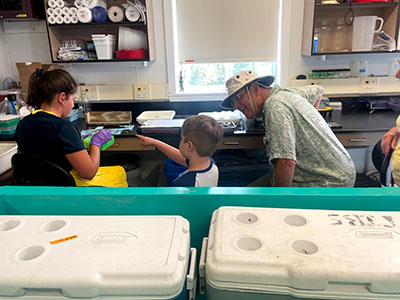
Photo: Nels and Logan get up close as student Anna Conklyn carefully dissects and processes a round goby, as part of her PhD research.
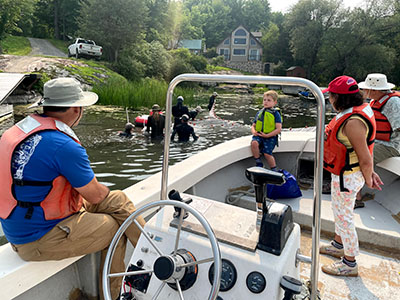 Photo: The Magnusons help John check in on the TIBS seining crew and learn about the importance
of this standardized survey to monitor trends in fish populations and inform management
decisions.
Photo: The Magnusons help John check in on the TIBS seining crew and learn about the importance
of this standardized survey to monitor trends in fish populations and inform management
decisions.
St. Lawrence Ecosystem Stressors: Round Gobies and VHSV
PhD Candidate Anna Conklyn
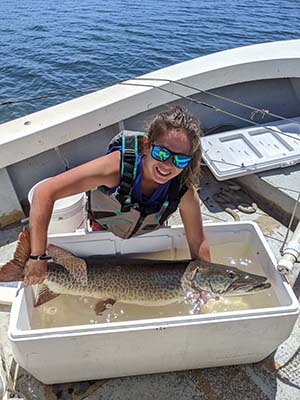 Photo: Anna with adult muskie captured during long term spring monitoring survey.
Data collected are used to evaluate health of the St. Lawrence muskie population.
Photo: Anna with adult muskie captured during long term spring monitoring survey.
Data collected are used to evaluate health of the St. Lawrence muskie population.
Approximately 180 species of non-native organisms have been introduced into the Great Lakes basin via human activities. Most of these introductions are associated with long-distance trade and release of ship ballast water from across the Atlantic Ocean. As a critical component of the Great Lakes Seaway system, the St. Lawrence River has been significantly impacted by many non-native species. Exotic introductions can reduce ecosystem stability, depending on the amount of impact the organism has on native species and ecosystem processes. Introduced organisms that are known to have a substantial, directly negative impact on environmental functions and native biodiversity are called aquatic invasive species (AIS). Many introduced organisms are native to the Ponto Caspian region of Eastern Europe, including some of the most disruptive AIS to the Great Lakes and surrounding waters. Examples include the zebra and quagga mussels, round goby, tubenose goby, fishhook waterflea, and Eurasian amphipod. Together, these exotic species have changed nutrient cycles, food web structure, and habitat competition across the entire Great Lakes watershed. One AIS that is closely monitored by TIBS is the round goby. These bottom dwelling fish have reached extremely high density in the St. Lawrence and pushed out native species, completely altering the forage base for predatory sportfish. Importantly, they also act as a reservoir for viral hemorrhagic septicemia virus (VHSV), which causes a disease that collapsed the muskellunge population. PhD candidate Anna Conklyn has been researching the round goby during her program, looking at their role as a carrier for VHSV. Anna’s project represents one of TIBS’ collaborative partnerships, involving the NYS DEC, Dr. Rod Getchell at the Cornell Aquatic Animal Health Center, and the NYS Water Resources Institute. Anna’s research goals are to determine which round goby population groups experience the most VHSV infections and to compare their viral carrier role to native community members in the Thousand Islands.
From 2005-2008, VHSV swept across the Great Lakes. This new pathogen caused outbreaks in many areas of the basin that involved 28 species of fish. The St. Lawrence River experienced some of the most severe VHSV mortalities during this period that contained numerous adult muskellunge and recently invaded round gobies. The significant adult muskie losses led to destabilization of their natural spawning capacity, resulting in the extremely limited reproduction we have observed since the emergence of VHSV. In large outbreaks, this virus can cause hemorrhaging on the fins, eyes, gills, skin, muscle or organs and subsequent death of infected fish. However, many fish that have tested positive during surveillance for the virus have no visible symptoms of disease, but may still be capable of transmitting the virus to other fish by cohabitation or predation. Some asymptomatic round gobies in Anna’s research have had extraordinarily high viral copy numbers, upwards of 10 million copies per 0.00000005 grams of tissue! This extreme viral replication is likely to create many genetic mutations that can allow the virus to evolve and cause future outbreaks. Since the emergence of VHSV in the Great Lakes, the virus has gone more incognito with fewer outbreaks that create large masses of dead fish. However, Anna’s data has observed a constant presence of the virus in many muskie nursery bays throughout the region.
Anna has tested several native species (i.e., yellow perch, brown bullhead, rock bass, bluegill, and pumpkinseed) for VHSV as part of her research, and this effort has demonstrated that round gobies have much higher viral prevalence and can replicate many more viral copies compared to susceptible native species. Round gobies have many characteristics that prime them to serve as a major carrier for the virus. They are extremely abundant, densely populated, and are important forage throughout the river, creating frequent points of contact that can transmit the virus. Round gobies also have life history traits that support early maturation, fast growth, and large reproductive output. These qualities have enabled their expansion as an invasive species but can also oppose development of immune responses that can suppress viral replication and transmission. This suggests that, due to their invasion biology, round gobies will remain a very suitable host for VHSV even as the virus reaches further into the period of endemicity. In the coming months, Anna will be sequencing the viral genomes from her samples to examine the amount of genetic mutation that has occurred in round gobies and other hosts across different sites and years. This will give us a better picture of how much evolution VHSV is undergoing in the Thousand Islands and allow us to better predict the future of the pathogen in the St. Lawrence. The future impact of VHSV on muskellunge recovery is going to be driven by the frequency of disease recurrence, because longer-lived and slower growing species like the muskie are much more sensitive to substantial population losses that can be perpetuated by persistent disease.
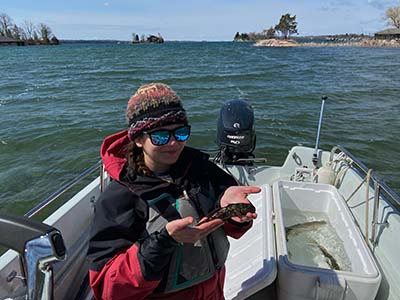 Photo: Anna with round goby to be used as part of her sample for investigation of
their influence on disease transmission. Large gobies like this one here are typically
males.
Photo: Anna with round goby to be used as part of her sample for investigation of
their influence on disease transmission. Large gobies like this one here are typically
males.
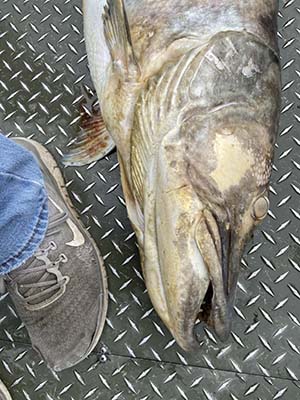
Photo: Large 56" adult muskie found dead near Flynn Bay in spring 2022. This is one of the several diseased muskie found this year including one testing positive for VHSV in April.
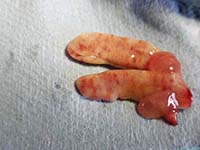
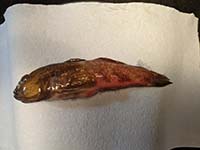
Photo: Hemorrhaging organs (left) and Hemorrhaging round goby infected by VHSV (right)
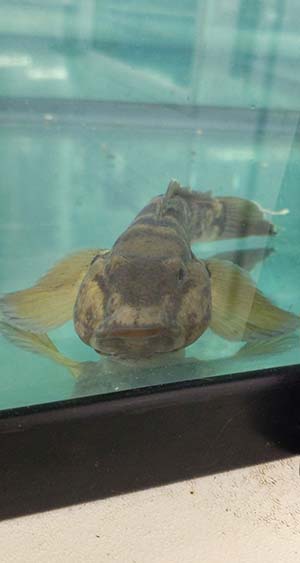 Photo: Anna completed experimental trials to examine viral shedding in the environment.
It is believed the virus is released through the gills exposing other fish to the
disease.
Photo: Anna completed experimental trials to examine viral shedding in the environment.
It is believed the virus is released through the gills exposing other fish to the
disease.
The Thousand Islands region has been strongly affected by VHSV over the last fifteen years, with consistently high prevalence of VHSV, many observed fish kills in the region, and significantly declining populations of muskellunge. The invasion of round gobies has markedly changed the community structure and forage base in spawning and nursery habitats, and their influence on VHSV ecology is a critical aspect of their environmental impact. Anna’s research is providing important details regarding the carrier ability of round gobies and native susceptible species, including their likelihood to be infected, how many viral copies they can replicate, and how much they contribute to VHSV genetic mutation. This insight will give meaningful new context to predict the continued risk of VHSV exposure in the Thousand Islands. A better understanding of the status and future drivers of VHSV is crucial for our program to implement informed and effective restoration ecology toward the muskellunge as we work to rehabilitate populations in the region. There are many upcoming results from Anna’s dissertation before her planned graduation date in May 2023, so keep an eye out for future updates!
Thank You to Our First 100 TIBS Friends!
We are excited to announce that since our start in spring 2021, we have reached over 100 TIBS Friends and helped us raise over $165,000! Because of your generosity, we have been able to create a new endowed student scholarship, launch the new muskie citizen science program, purchase needed research supplies, host new educational events, and are working towards creating a new position specializing in science communication at TIBS. This all would not have been possible without your support and we Thank You!
Honor Roll of Donors
Musky Enthusiast ($5,000+)
Maitland Tower Corp.
Muskies Canada Sport Fishing & Research, Inc
Nels and Deborah Magnuson
Werner Family
Thousand Islands Supporter ($1,000)
Allan P. Newell
Andrea Risoli
Daniel Cawley
Eagle Shoppe and 1000 Islands 40 Acres Clothing Co.
John and Kim Farrell
John and Marjorie Hart
Mary Remington Omam
Michael Little
Northern NY Community Foundation, Inc.
Rob Claypoole
The Miller S. Adelaide S. Gaffney Foundation
The Musky Symposim (Muskies, Inc.)
River Ecologist ($500)
Jane D. Carver
Liz O'Rourke
Ted and Mary Mascott
Islander Member ($100)
Aleander Curry
Amy L. Shaw Baldwin
Andy Skop
Ann B. Ward
Brandeis L. Neveldine
Caroline Larson
David Duff
George Davis
Heather White
James McGarry
Jennifer J. Caddick
John Peach
Kirstin M. Hawley
Kyle Mcculloch
Masshkinoozhe Guide Service
Matthew B. Elliott
Melissa Murashige
Pfizer, Inc.
Rob J. Campany
Sebastian R. Borrello
Stefan G. Dirghalli
Stephen Sarfaty
Steven Thomas
Friend
Adam Wannamaker
Anthony Holstein
Anthony Lasher
Blake Baker
Bob Fantauzzi
Brandon Schorle
Brian Leech
Charles Mueller
Cody Goodchild
Dakota Repinski
Dave Kormanyos
David R. Vezendy
Derek Hildebrandt
Dwayne Viggers
Eric Fredrickson
Eric Gladding
Georgia Hoffman
Gary Harrison
Gary Jallen
Grant Hesselroth
Jacob Keehn
Jack Marshall
James Madigan
Jason Brozzo
Jason Eslinger
Jason Rajan
Jay Grenon
Joe Hadlock
Joe Stagnitti
Jonathan Dunning
Jonathan Dupont
Joseph Wilczewski
JP Braband
JP Haworth
Kenneth D. Larson
Kevin Delforge
Kevin Michnicki
Kris Kuc
Lee Harper
Mark Aanenson
Mark Siemonsen
Mat Haas
Michael Barillari
Michael E. Guinan
Mike Nemisz
Nicklas Kushnerik
Noah Eschenbauch
Peter Aweeky
Robb Myers
Robert Bickle
Robert Hansen
Robert Kiffmeyer
Russell Boelkow
Ryan Abramson
Ryan Hipditch
Scott Burke
Scott L. Schlueter
Scott Mueller
Sean Ryan
Shandra Dinsmore
Siddharth Motwani
Spencer Anderson
Travis Conrad
Wade Palashewski
Zac Buwalda
Thank you to our Partner Organizations and Volunteers!
Your support of the Friends has been critical to our success! Thank you for hosting us for workshops, bringing your members to the research station, spreading our message, and helping expand our network- we really appreciate your support! A special thanks goes out to:
Antique Boat Museum
DK Musky Lures
Muskies Canada, Gananoque 1000 Islands Chapter
Muskies, Inc. Chapter 69 and Chapter 70
Save the River
Thousand Islands Land Trust
REMINDER TO RENEW FOR 2022-2023!
Please renew your TIBS Friends membership for this coming year. Membership renewal
is available HERE, and thank you so much for your continued support!
For questions or to learn other ways you can help support TIBS, contact Brandy Neveldine, [email protected]
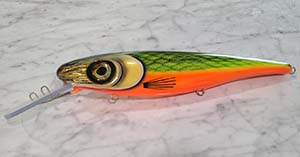 Photo: A special Thank You to Dave Kormanyos of DK Musky Lures who recently raffled
off one of his prized, one-of-a-kind and handmade musky lures to raise support for
the TIBS Friends and our Musky restoration program
Photo: A special Thank You to Dave Kormanyos of DK Musky Lures who recently raffled
off one of his prized, one-of-a-kind and handmade musky lures to raise support for
the TIBS Friends and our Musky restoration program
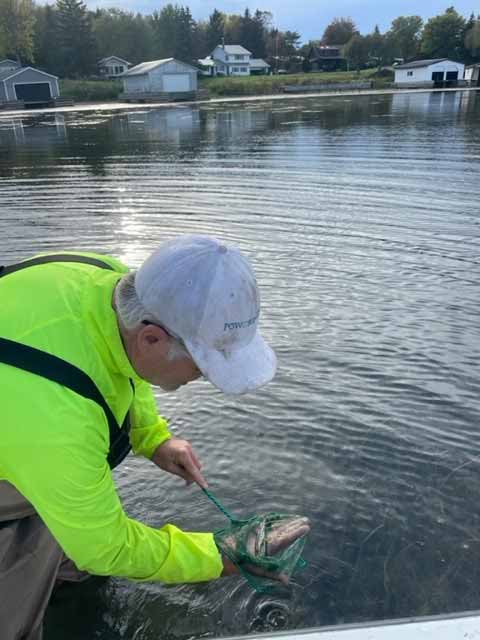
Photo: TIBS Friend, Philip Ling, seines with the crew and releases recaptured musky fingerling back into Rose Bay
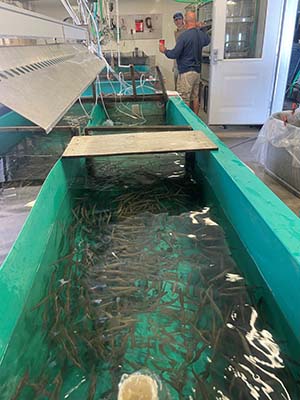 Photo: Muskie in the TIBS research lab just prior to release in early September.
Photo: Muskie in the TIBS research lab just prior to release in early September.
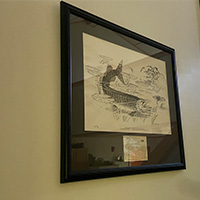 Photo: Generously donated by Mr. Andy Skop of Wolfe Island, two new beautifully professionally
mounted musky prints from his personal collection will now be on display in the Cean
Research Building at TIBS. The donated pieces include an original 1981 artist proof
commissioned for the Federated Sportsmen Club of Jefferson County, and a personally
framed Michael Ringer.
Photo: Generously donated by Mr. Andy Skop of Wolfe Island, two new beautifully professionally
mounted musky prints from his personal collection will now be on display in the Cean
Research Building at TIBS. The donated pieces include an original 1981 artist proof
commissioned for the Federated Sportsmen Club of Jefferson County, and a personally
framed Michael Ringer.
Major Donor Giving Opportunities
As a major donor to TIBS, you will be leading the charge to secure the future of TIBS and the future of our students. Major sponsors have the opportunity to directly contribute to several critical fundraising needs to support the longevity of the station and our programs. For more information on how you can support TIBS as a Major sponsor contact :
Brandy Neveldine
ESF Development Office
[email protected]
(315) 470-6683
